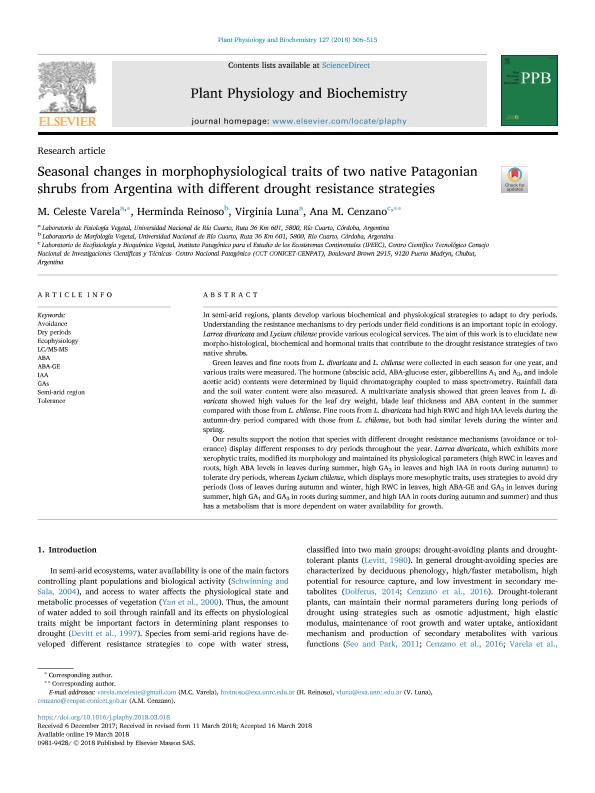Artículo
Seasonal changes in morphophysiological traits of two native Patagonian shrubs from Argentina with different drought resistance strategies
Fecha de publicación:
06/2018
Editorial:
Elsevier Masson
Revista:
Plant Physiology and Biochemistry
ISSN:
0981-9428
Idioma:
Inglés
Tipo de recurso:
Artículo publicado
Clasificación temática:
Resumen
In semi-arid regions, plants develop various biochemical and physiological strategies to adapt to dry periods. Understanding the resistance mechanisms to dry periods under field conditions is an important topic in ecology. Larrea divaricata and Lycium chilense provide various ecological services. The aim of this work is to elucidate new morpho-histological, biochemical and hormonal traits that contribute to the drought resistance strategies of two native shrubs. Green leaves and fine roots from L. divaricata and L. chilense were collected in each season for one year, and various traits were measured. The hormone (abscisic acid, ABA-glucose ester, gibberellins A1 and A3, and indole acetic acid) contents were determined by liquid chromatography coupled to mass spectrometry. Rainfall data and the soil water content were also measured. A multivariate analysis showed that green leaves from L. divaricata showed high values for the leaf dry weight, blade leaf thickness and ABA content in the summer compared with those from L. chilense. Fine roots from L. divaricata had high RWC and high IAA levels during the autumn-dry period compared with those from L. chilense, but both had similar levels during the winter and spring. Our results support the notion that species with different drought resistance mechanisms (avoidance or tolerance) display different responses to dry periods throughout the year. Larrea divaricata, which exhibits more xerophytic traits, modified its morphology and maintained its physiological parameters (high RWC in leaves and roots, high ABA levels in leaves during summer, high GA3 in leaves and high IAA in roots during autumn) to tolerate dry periods, whereas Lycium chilense, which displays more mesophytic traits, uses strategies to avoid dry periods (loss of leaves during autumn and winter, high RWC in leaves, high ABA-GE and GA3 in leaves during summer, high GA1 and GA3 in roots during summer, and high IAA in roots during autumn and summer) and thus has a metabolism that is more dependent on water availability for growth.
Palabras clave:
ABA
,
ABA-GE
,
AVOIDANCE
,
DRY PERIODS
,
ECOPHYSIOLOGY
,
GAS
,
IAA
,
LC/MS-MS
,
SEMI-ARID REGION
,
TOLERANCE
Archivos asociados
Licencia
Identificadores
Colecciones
Articulos(CCT - CORDOBA)
Articulos de CTRO.CIENTIFICO TECNOL.CONICET - CORDOBA
Articulos de CTRO.CIENTIFICO TECNOL.CONICET - CORDOBA
Articulos(IPEEC)
Articulos de INSTITUTO PATAGONICO PARA EL ESTUDIO DE LOS ECOSISTEMAS CONTINENTALES
Articulos de INSTITUTO PATAGONICO PARA EL ESTUDIO DE LOS ECOSISTEMAS CONTINENTALES
Citación
Varela, María Celeste; Reinoso, Herminda Elmira; Luna, Maria Virginia; Cenzano, Ana María; Seasonal changes in morphophysiological traits of two native Patagonian shrubs from Argentina with different drought resistance strategies; Elsevier Masson; Plant Physiology and Biochemistry; 127; 6-2018; 506-515
Compartir
Altmétricas




